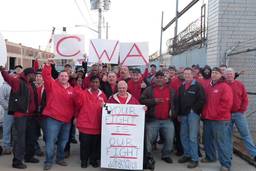Last week , after Occupy protesters attempted (with some success) to blockade West Coast ports without the consent of the International Longshoremen and Warehouse Union (ILWU), some Occupy activists claimed that the lack of union support for the shutdown was evidence that labor leaders are sout of touch with the rank-and-file.
As Emily Loftis, an Occupy activist, wrote in Salon, “Just as the 1 percent now has to listen to the 99 percent, Big Labor has to listen to the rank and file.”
It’s debatable whether or not the ILWU fits this description, given the union’s long history of militant democratic trade unionism (some of which I have reported on for In These Times). But Occupiers’ overall critique of America’s labor movement as being out of touch with rank-and-file workers does have some merit. Would many port workers have objected to Occupy activists shutting down East Coast ports, where the International Longshoreman Association has a long history of corruption, mob influence, and behind-the-scenes dealmaking at the expenses of members?
As I have covered on various occasions, many unions have been willing to accept concessions in lieu of mobilizing members to resist them, as evidenced in part by statistics that show that the annual number of strikes in the country has sunk to all-time lows. In the case of the West Coast longshoreman struggle, the Occupy movement may have found the wrong target for their militancy. But that’s not to say there aren’t ongoing labor struggles where outside forces like the Occupy movement could shake things up by injecting some militancy into trade unions.
“During the whole port discussion, not one time did the word railroad get mentioned. Truckers were mentioned, but somehow the railroad was invisible despite large railroad tracks going into nearly every single one of these ports,” says Ron Kaminkow, General Secretary of Railroad Workers United, a caucus of rank-and-file reformers from 17 different railroad unions who are hoping to make the railroad unions more militant.
For the last several months, 17 different railroad unions — which represent a total of 105,000 railroad workers across three bargaining units — have been negotiating with an industry association of more than 30 railroad companies. Despite the four largest railroads making $8.5 billion in profits last year, the railroads have demanded that workers make big concessions including increasing their healthcare contributions by an average of $200 a month.
In October, 35,000 railroad workers, members of the Brotherhood of Locomotive Engineers and Trainmen, attempted to strike, but were blocked by powers granted to President Obama under the Railways Labor Act, as I covered for In These Times.
Around that time, the labor committee of Occupy Wall Street passed a resolution supporting the railroad workers, saying,
The Labor Outreach Committee of Occupy Wall Street supports the 92,000 railroad workers currently faced with demands by the railroad magnates for concessions in wages and benefits. We also unconditionally support their right to strike, a right that President Obama has denied them by invoking the powers granted him by the draconian Railway Labor Act, which outlaws strikes and allows Congress to impose a contract, and we stand ready to support them in the event of a strike.
This resolution, however, was the biggest statement made by the Occupy Movement to support the railroad workers’ cause, as there was no effort to take concentrated direct action, as Occupy Oakland and other West Coast groups did.
In the two months that followed, a Presidential Emergency Board recommended that railroad workers unions accept concessions as a bipartisan effort in Congress threatened to stop any strike by railroad workers. Instead of occupying the tracks of railroads in an effort to support the railroad workers and do what Congress would prevent them from doing, no major action on the scale of the West Coast port shutdown was taken by Occupy members and railroad unions quietly accepted concessionary contracts without much public support, as I recently covered for In These Times.
“What happened is what always happens when railroad workers are blocked by federal law from striking. Unions basically bargained against other unions, hoping to beat out other unions in making deals for their specific craft. There was no real unity in bargaining or any serious effort by the 17 unions to play chicken by forcing a Democratic Senate to pass legislation stopping us from striking,” Kaminkow says.
Kaminkow says he would have welcomed Occupy members taking militant action to stop the railroads in an effort to shake up the railroad unions and force them to be more militant in fighting concessions.
“Rail unions aren’t any more democratic than most other unions, they are just business unions. They are about cutting deals with the bosses, not really mobilizing the members,” he says. “It’s a whole culture problem, where these unions have never really been proper fighting instruments… We don’t have that kind of militant culture of a union like the ILWU.”
As the Occupy Movement hopes to use its militancy to fight on behalf of the 99% in labor struggles, the key may be for them to find the labor struggles where their militancy is needed. It’s also important for groups of workers like the railroad workers to make their struggles inclusive, so outside groups like Occupy can feel invited to join the fight.
While there will be tension at times between social movements like Occupy and unions, labor strategist Stephen Lerner argues that such tension will inevitably occur in movements with the necessary power to create social change.
“If we can control it, by definition it is too small to matter and win the transformative change we need. Movements are messy, and complicated, it is natural that there will be lots of tension between established groups and emerging movements,” says Lerner. “It’s through common battles that together we can create something big enough to matter.”








